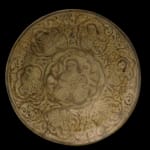Fatimid Lustre Painted Plate, 11th Century CE - 12th Century CE
Glazed Earthenware
34 x 7.9 cm
13 3/8 x 3 1/8 in
13 3/8 x 3 1/8 in
LO.1381
Coarse stonepaste with white ground slip beneath blue glaze, opaque yellow-white slip to interior with lustre decoration beneath clear, crackled glaze; rounded sides rise up from short, vertical footring to...
Coarse stonepaste with white ground slip beneath blue glaze, opaque yellow-white slip to interior with lustre decoration beneath clear, crackled glaze; rounded sides rise up from short, vertical footring to carinated keel just above midpoint before terminating in everted rim; decoration consists of lobed cartouche at centre with seated figure and six radiate, seated figures to cavetto against floral and eyes; blue glaze to exterior walls. Repaired from fragments. A “golden age” for pottery.
Figures in monumental style are again found in cartouches. The radiate figures bear a striking resemblance to a bowl assigned with a provenance of Iran currently on display at Kuwait National Museum. The blue-glaze reverse is a feature commonly found in monumental style lustres, but rarely in other styles.
Informal naturalism, executed in free hand. Design is well laid out and executed with reserve despite the informal nature Figurative depictions are not uncommon and generally are bound up with the “pleasures of court” Only a few Fatimid lustre pieces are known painted with human figures in this very naturalistic manner, a tradition that can be traced back to pre-Islamic Hellenistic Egypt.
Of particular interest here is we have a monochrome blue slip beneath the lustre, suggesting this bowl started life as a monochrome glazed ware and the lustre was applied at a later, though still close, date.
While repaired, it is most unusual to find a complete piece and most Fatimid lustre ware survives to us in fragments.
Throne scene, central figure has halo. For similar figures cf. Watson, P.348 Cat.O.
Figures in monumental style are again found in cartouches. The radiate figures bear a striking resemblance to a bowl assigned with a provenance of Iran currently on display at Kuwait National Museum. The blue-glaze reverse is a feature commonly found in monumental style lustres, but rarely in other styles.
Informal naturalism, executed in free hand. Design is well laid out and executed with reserve despite the informal nature Figurative depictions are not uncommon and generally are bound up with the “pleasures of court” Only a few Fatimid lustre pieces are known painted with human figures in this very naturalistic manner, a tradition that can be traced back to pre-Islamic Hellenistic Egypt.
Of particular interest here is we have a monochrome blue slip beneath the lustre, suggesting this bowl started life as a monochrome glazed ware and the lustre was applied at a later, though still close, date.
While repaired, it is most unusual to find a complete piece and most Fatimid lustre ware survives to us in fragments.
Throne scene, central figure has halo. For similar figures cf. Watson, P.348 Cat.O.



